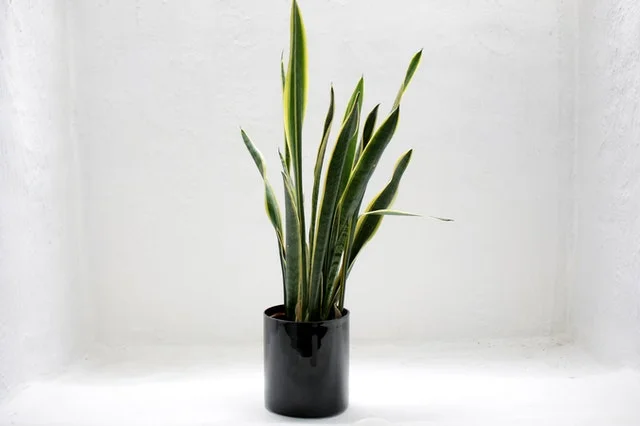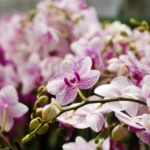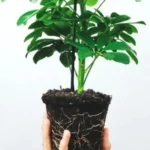The black coral snake plant is a slow-growing flowering plant from the tropical regions of West Africa. The typical height is between 29-39 inches (75-100cm).
It produces thick and luscious dark green leaves, sometimes almost black, that have horizontal bands of lighter green, white, and grey. These leaves can grow to be about 2.5-inches wide.
These beautiful plants make lovely houseplants for their appearance, air-purifying qualities, and the level of care required.
In fact, these plants not only find their place in homes but also in offices because they can live with such little care. They make the perfect decorative piece for many ledges and windowsills.
Table of Contents
Black Coral Snake Plant Care
These plants tend to be strong and resilient. While they prefer certain environments over others, they readily adapt to thrive.
They adapt better to neglect than to overwatering, as too much water can cause them to develop an illness. To survive and thrive, there are only a few components required.
What does your black coral snake plant require?
As with any plant, this one needs several provisions. There are six different elements, and while this might seem like a lot, in terms of plant care, the actual requirements are minimal. Here is a look at those needs and how they can be fulfilled.
Light Requirements
This snake plant will adapt to low lighting, but it thrives in bright to moderate indirect light. Direct light could scorch its leaves.
Temperature Requirements
The foliage is healthier at temperatures between 15-23 degrees Celsius (59-73 degrees Fahrenheit).
It can tolerate temperatures as low as 10 degrees Celsius (50 degrees Fahrenheit) for short periods, but it needs to be brought back to warmer temperatures to reinvigorate. The plant cannot tolerate frost.
Humidity Requirements
Snake plants prefer high levels of air humidity. In drier air conditions, an air humidifier may be employed, or a fine mist can be sprayed into the air.
Water Requirements
The soil must be permitted to dry in between waterings. Watering can be done once the soil is dry but should be able to drain freely from the pot and soil.
The roots must not sit in water as root rot or other fungal issues may form.
Soil Requirements
Standard potting mix or that designed for succulent plants work well for this species. Any potting mix used must be well-draining, and it needs to be in a pot or container with adequate drainage.
Fertilizer Requirements
A diluted dose of cactus or general-purpose fertilizer may be added once per month in the growing season. Being a low-maintenance plant, it does not require a lot of plant food or extra nutrition.
Adding too little fertilizer is better than adding too much as the latter could cause damage.
Extra Tips For A Black Coral Snake Plant
These plants may require very little care, but it is always handy to have additional knowledge for their care.
The following tips pertain to dealing with insects and illnesses as well as how to properly prune and propagate the foliage.
Pests and Diseases
This species of snake plant are incredibly resistant to insects because their leaves are thick and tough. Insects tend to have difficulty trying to feed on them. The main issues that these plants have pertain to fungal disease.
One type, in particular, is root rot, but there may be others. There is another rare but additional potential issue listed as well.
- Root Rot: This fungal disease is often caused by overwatering. The water does not drain quickly enough from the pot, and the roots sit in this moisture for extended periods. This additional moisture creates the perfect environment for fungus to develop. This illness may first be noticed at the base of the plant as a discoloration of the leaves or stalks. The affected areas may be black or brown. The upper leaves may be discolored also, they might become yellow or brown. This issue may be treated by either repotting the plant into fresh soil with a new pot or allowing the current potting mix to dry out. Fungicides may be required. Damaged and infected areas must be cut away, including the roots.
- Water Toxicity: This issue relates to the water that is added to the soil. In some areas, there are chemicals added to the water. If brown spots start to appear on the leaves that are not related to fungus, the caregiver is advised to only use filtered water or that which has been left to stand at room temperature overnight.
Pruning
Pruning may be done at any time, especially if the areas trimmed are damaged. However, if the task is being done for cutting back its size, propagating, or other reasons not related to plant-health, it is often best left to the growing seasons, spring and summer.
Before pruning, the leaves should be checked for insects or illnesses. Once this is done, the leaves can be cut with sterilized sharp pruners or a knife at a spot near the soil. The cutting tool should be sterilized after each cut, especially if trimming off damaged areas.
Propagation
These plants are propagated through cuttings or division. Cuttings are of three-inch sections of leaves. The lower part of the leave can be set into damp sand to develop roots.
Propagating in such a way does not guarantee that the plant will have the stripes or banding of the mother plant.
Propagating through division tends to be easier, and it also produces plants with the stripes of color. To do this, the caregiver must remove the entire plant from the soil.
The soil needs to be gently shaken from the roots, and sharp, sterile pruning shears or scissors used to divide the plant into various sections. Each viable division must have part of the root system and should be planted into separate pots with a potting mix designed for succulents.
Propagation should be completed in spring for better results.
Toxicity
Black coral snake plants are mildly toxic to humans and animals if ingested. It is best to keep these plants out of the reach of children and pets.
Photo by Fabian Stroobants from Pexels



